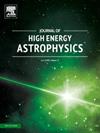Shadow images of Ghosh-Kumar rotating black hole illuminated by spherical light sources and thin accretion disks
IF 10.5
4区 物理与天体物理
Q1 ASTRONOMY & ASTROPHYSICS
引用次数: 0
Abstract
This study investigates the astronomical implications of the Ghosh-Kumar rotating Black Hole (BH), particularly its behaviour on shadow images, illuminated by celestial light sources and equatorial thin accretion disks. Our research delineates a crucial correlation between dynamics of the shadow images and the parameters a, q and the , which aptly reflect the influence of the model parameters on the optical features of shadow images. Initially, elevated behaviour of both a and q transforms the geometry of the shadow images from perfect circles to an oval shape and converges them towards the centre of the screen. By imposing the backward ray-tracing method, we demonstrate the optical appearance of shadow images of the considering BH space-time in the celestial light source. The results demonstrate that the Einstein ring shows a transition from an axisymmetric closed circle to an arc-like shape on the screen as well as producing the deformation on the shadow shape with the modifications of space-time parameters at the fixed observational position. Next, we observe that the attributes of accretion disks along with the relevant parameters on the shadow images are illuminated by both prograde and retrograde accreting flow. Our study reveals the process by which the accretion disk transitions from a disk-like structure to a hat-like shape with the aid of observational angles. Moreover, with an increase of q, the observed flux of both direct and lensed images of the accretion disk gradually moves towards the lower zone of the screen. Furthermore, we present the intensity distribution of the red-shift factors on the screen. Our analysis suggests that the observer can see both red-shift and blue-shift factors on the screen at higher observational angles, while augmenting the values of both a and q, enhancing the effect of red-shift on the screen.
Ghosh-Kumar旋转黑洞在球形光源和薄吸积盘照射下的阴影图像
这项研究调查了Ghosh-Kumar旋转黑洞(BH)的天文学意义,特别是它在天体光源和赤道薄吸积盘照射下的阴影图像上的行为。我们的研究描述了阴影图像的动力学与参数a、q和θobs之间的重要相关性,这很好地反映了模型参数对阴影图像光学特性的影响。最初,a和q的升高行为将阴影图像的几何形状从完美的圆形转变为椭圆形,并将它们汇聚到屏幕的中心。通过引入反向光线追踪方法,我们展示了天体光源中考虑黑洞时空的阴影图像的光学外观。结果表明,爱因斯坦环在屏幕上呈现出由轴对称闭合圆向圆弧形状转变的过程,并在固定观测位置随着时空参数的改变在阴影形状上产生变形。接下来,我们观察到吸积盘的属性以及阴影图像上的相关参数被顺行和逆行吸积流照亮。我们的研究借助观测角度揭示了吸积盘从盘状结构转变为帽状结构的过程。而且,随着q的增大,吸积盘直接像和透镜像的观测通量都逐渐向屏幕下方区域移动。此外,我们给出了红移因子在屏幕上的强度分布。我们的分析表明,观测者在更高的观测角度下可以同时看到屏幕上的红移和蓝移因素,同时增大了a和q的值,增强了屏幕上的红移效果。
本文章由计算机程序翻译,如有差异,请以英文原文为准。
求助全文
约1分钟内获得全文
求助全文
来源期刊

Journal of High Energy Astrophysics
Earth and Planetary Sciences-Space and Planetary Science
CiteScore
9.70
自引率
5.30%
发文量
38
审稿时长
65 days
期刊介绍:
The journal welcomes manuscripts on theoretical models, simulations, and observations of highly energetic astrophysical objects both in our Galaxy and beyond. Among those, black holes at all scales, neutron stars, pulsars and their nebula, binaries, novae and supernovae, their remnants, active galaxies, and clusters are just a few examples. The journal will consider research across the whole electromagnetic spectrum, as well as research using various messengers, such as gravitational waves or neutrinos. Effects of high-energy phenomena on cosmology and star-formation, results from dedicated surveys expanding the knowledge of extreme environments, and astrophysical implications of dark matter are also welcomed topics.
 求助内容:
求助内容: 应助结果提醒方式:
应助结果提醒方式:


